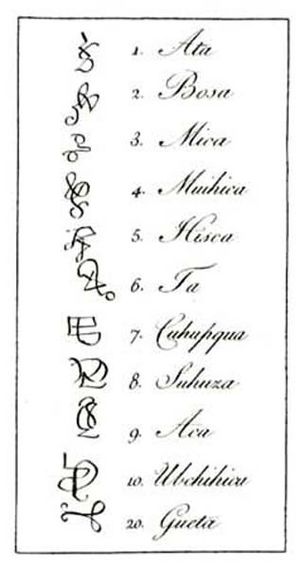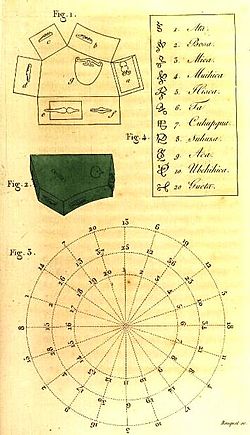Muisca calendar facts for kids
The Muisca calendar was a special way the Muisca people kept track of time. It was a lunisolar calendar, which means it used both the Moon and the Sun to figure out dates. This calendar was quite complex! It had different kinds of months and three main types of years:
- Rural years (called chocan in their language, Chibcha)
- Holy years (called acrótomo in Spanish)
- Common years (called zocam in Chibcha)
Each month in the Muisca calendar had thirty days. A common year had twenty months. Why twenty? Because twenty was a very important number for the Muisca. It represented all their fingers and toes combined! The rural year usually had twelve months, but sometimes they added an extra "leap month." This extra month was called the "deaf month" (mes sordo in Spanish) and was a time for rest. The holy year was the longest, with 37 months.
The Muisca lived in the high mountains of Colombia (the Altiplano Cundiboyacense). They had one of the most advanced calendar systems in Pre-Columbian America. Other advanced calendars belonged to the Incas, the Maya, and the Aztecs.
Many important scholars have helped us learn about the Muisca calendar and their counting system. These include the Spanish conquistador Gonzalo Jiménez de Quesada, who met the Muisca in 1537. Later, people like Bernardo de Lugo, Pedro Simón, Alexander von Humboldt, and José Domingo Duquesne shared their findings. In more recent times, Javier Ocampo López and Manuel Arturo Izquierdo Peña have continued this important research.
Contents
How the Muisca Counted
The Muisca used a counting system based on the number twenty. This is called a vigesimal system. They often counted using their fingers and toes.
For numbers higher than ten, they used a special word: quihicha or qhicha. This word meant "foot" in their language, Muysccubun. So, eleven was "foot one," twelve was "foot two," and so on.
The number 20 was very special. It was the total number of all their fingers and toes. The Muisca had two ways to say twenty: "foot ten" (quihícha ubchihica) or their unique word gueta. This word gueta came from gue, which meant "house."
Numbers between 20 and 30 were counted like "twenty plus one" (gueta asaqui ata) for 21. "Twenty plus ten" (gueta asaqui ubchihica) meant 30. For even larger numbers, they used multiples of twenty. For example, "20 times 2" (gue-bosa) was 40, and "20 times 5" (gue-hisca) was 100.
The Muisca also had a form of writing using hieroglyphs, but these were only used for numbers.
Muisca Numbers 1 to 10 and 20
Here's how some Muisca numbers looked and sounded:
| Number | Humboldt, 1878 | De Lugo, 1619 | Muisca hieroglyphs |
|---|---|---|---|
| 1 | ata | ||
| 2 | bozha / bosa | boʒha | |
| 3 | mica | ||
| 4 | mhuyca / muyhica | mhuɣcâ | |
| 5 | hicsca / hisca | hɣcſcâ | |
| 6 | ta | ||
| 7 | qhupqa / cuhupqua | qhûpqâ | |
| 8 | shuzha / suhuza | shûʒhâ | |
| 9 | aca | ||
| 10 | hubchibica / ubchihica | hubchìhicâ | |
| 20 | quihicha ubchihica gueta |
qhicħâ hubchìhicâ guêata |
|
Counting Higher for Days and Months
When naming days and months, the Muisca usually didn't use numbers higher than 10. The only exception was gueta for the 20th month. This meant the 11th month was named just like the 1st month, ata. The same went for other months and days up to 19. This system could be a bit confusing. However, the Muisca used their three different types of years to help tell the difference.
How the Muisca Measured Time
The Muisca calendar was a mix of different time periods. These periods ranged from weeks to years and even longer spans. The length of a day was based on the Sun's daily cycle. A month was based on the Moon's cycles.
Days
The Muisca word for "day" was sua, which also meant "Sun." "Night" was called za. Their priests divided the day into four parts:
- suamena: from sunrise to midday
- suameca: from midday to sunset
- zasca: from sunset to midnight
- chaqüi: from midnight to sunrise
Weeks and Months
Historians have different ideas about how the Muisca organized their weeks. Some say a month had three weeks of ten days. Others suggest two weeks of 15 days. Some even thought a Muisca week had only three days, with ten weeks in a month.
It's possible the Muisca didn't have a fixed "week" like we do. Instead, they might have organized their days based on different activities in their daily lives.
The Muisca, like the Incas, likely understood the difference between two types of lunar months:
- The synodic month: about 29.5 days, which is the time between two full Moons.
- The sidereal month: about 27.3 days, which is the time it takes for the Moon to return to the same spot among the stars.
Years
The Muisca word for "year" was zocam. They always used it with a number. For example, zocam ata meant "year one," and zocam bosa meant "year two."
As mentioned, they used three types of years, each with a different number of months:
- The Rural Year: This year had 12 synodic months (based on the Moon's phases).
- The Priest's Year: This year was much longer, with 37 synodic months. Sometimes it was described as 12 + 12 + 13 months, where the 13th was a "leap month" for rest.
- The Common Year: This year had 20 months. This made a full common Muisca year about 600 days long. This is about 1.64 times longer than our Gregorian year. Some researchers believe this year was based on the sidereal lunar cycle (Moon's position relative to stars), unlike the other two.
The Muisca Calendar in Detail
To name the months, the Muisca didn't use numbers higher than 10, except for the 20th month, which was called gueta. The table below shows how the different types of years and months lined up. It also includes the meanings and activities linked to each month.
| Gregorian year 12 months |
Month 30 days |
Rural year 12 or 13 months |
Common year 20 months |
Holy year 37 months |
Symbols; "meanings" - activities |
|---|---|---|---|---|---|
| 1 | 1 | Ata | Ata | Ata | Jumping toad; "start of the year" |
| 2 | Bosa | Nose and nostrils | |||
| 3 | Mica | Open eyes and nose; "to look for", "to find" | |||
| 4 | Muyhica | Two closed eyes; "black thing", "to grow" | |||
| 5 | Hisca | Two fingers together; "green thing", "to enjoy" | |||
| 6 | Ta | Stick and cord; "sowing" - harvest | |||
| 7 | Cuhupqua | Two ears covered; "deaf person" | |||
| 8 | Suhuza | Tail; "to spread" | |||
| 9 | Aca | Toad with tail connected to other toad; "the goods" | |||
| 10 | Ubchihica | Ear; "shining Moon", "to paint" | |||
| 11 | Ata | ||||
| 12 | Bosa | ||||
| 2 | 13 | Bosa | Mica | ||
| 14 | Muyhica | ||||
| 15 | Hisca | ||||
| 16 | Ta | ||||
| 17 | Cuhupqua | ||||
| 18 | Suhuza | harvest | |||
| 19 | Aca | ||||
| 20 | Gueta | Lying or stretched toad; "sowing field", "to touch" | |||
| 21 | Bosa | Ata | |||
| 22 | Bosa | ||||
| 23 | Mica | ||||
| 24 | Muyhica | ||||
| 3 | 25 | Mica | Hisca | ||
| 26 | Ta | ||||
| 27 | Cuhupqua | ||||
| 28 | Suhuza | ||||
| 29 | Aca | ||||
| 30 | Ubchihica | harvest | |||
| 31 | Ata | ||||
| 32 | Bosa | ||||
| 33 | Mica | ||||
| 34 | Muyhica | ||||
| 35 | Hisca | ||||
| 36 | Ta | Embolismic month | |||
| 4 | 37 | Deaf month | Chuhupqua | End of the holy year; full cycle |
Celebrations
The Muisca had many celebrations. The month that lines up with our December was a time for big yearly feasts. These were especially important in a place called Sugamuxi (Sogamoso).
Clues from the Past: Archeological Evidence

We know about the Muisca calendar from many old objects and places. These include pottery, fabrics, spindles (tools for spinning thread), petroglyphs (rock carvings), and special stones.
Here are some important discoveries:
- Choachí Stone: Found in the early 1900s, this stone from Choachí might have been a tool to help convert different parts of the complex Muisca calendar.
- Ceremonial flute: This flute was made from a marine snail shell and found in Socorro. You can see it in the Archeology Museum Sogamoso.
- Decorated textile: Found in Belén, this fabric is now in the museum of Pasca. Some people call it a "Muisca codex," like an ancient book.
- El Infiernito: This is an important astronomical site of the Muisca, located near Villa de Leyva. It shows their knowledge of the stars.
- Jaboque: In this wetland area, ancient standing stones (menhirs) were found. These also point to the Muisca's understanding of astronomy.



